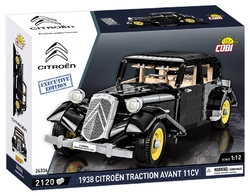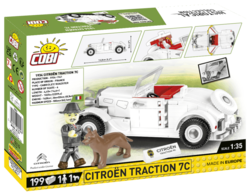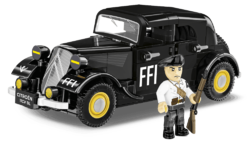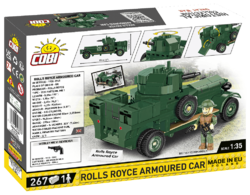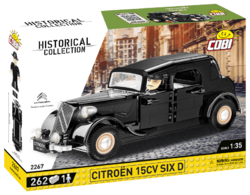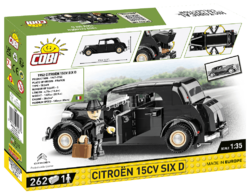Kit of the famous model of the revolutionary CITROËN Traction 11CV. The 1:12 scale model is finished in dark black with the typical emblem on the cooler. The front doors of the car open in the opposite direction to the real car. Under the opening hood is a detailed engine, the front wheels can be rotated. The model is produced under official licence from Automobiles CITROËN. The kit in the executive edition also includes a platform for displaying the model with a description compared to the standard version.
Show more
100 %
(1 Ranking)
| List Number: | COBI-24336 |
| EAN: | 5902251243364 |
| Warranty: | 24 months |
| Manufacturer: | COBI |
| Loyalty Points: | 17 |
| Price excluding VAT: | 2 174,73 Kč |
Description
Parametres
Files and Links
Discussion
Reviews1

You know that:
- At the very beginning of the revolutionary automotive design was a proposal by an Austrian engineer with Czech roots, Joseph Ledwinka, who, as an employee of the American coachbuilder Budd, presented the design in progress to his long-time business partner André Citroën, who was immediately intrigued and ordered its refinement.
- In 1933, the development of the car was undertaken by the duo of the designer, sculptor, artist F. Bertoni and the racing driver A. Lefébvre, whose collaboration resulted in an absolutely revolutionary car that was simply unrivalled at the time of its creation.
- Self-supporting construction, independent front-wheel suspension with torsion bars, the Citroën was a first.
- The design work on the first A7 series cars took a long time and André Citroën was running out of money, so he was forced to bring the car to market early, which resulted in a high failure rate in the early series.
- The Avant actually cost A. Citroën his life when he was forced to lay off several thousand employees and sell shares to tyre tycoon E. Michelin.
- Exhausted and broken, A. Citroën died in July 1935.
- At first, the public distrusted the technical innovations, and the carmaker had to demonstrate over and over again at numerous public events that Citröen cars were safe.
- In front of film crews, Citroën threw a car off an 8 metre cliff to prove that the self-supporting body was safe.
- There were two body styles on offer, the smaller BL and the almost 5m B.
- The 11CV was also used as a command vehicle by French General Charles Delestraint during the Battle of France.
- After the occupation of France, Ch. Delestraint became a major figure in the French Resistance.
- In total, more than 760,000 units were produced in various versions.
- The successor to the 11CV was the Citröen DS, also known for the Fantomas films, but that's another story.
Technical parameters:
- dimensions length 4,65 m, width 1,76 m, height 1,47 m
- weight 1155 kg
- power unit 4-cylinder 1 911 cc L R4 petrol engine with 42 kW
- maximum speed 122 km/h
- fuel consumption 7 l/100 km
- range approx. 700 km
- front-wheel drive
- number of speeds 3 forward and 1 reverse
- fuel tank 50 l
- number of seats 5
Instructions for assembly
| Number of figurines | 0 pcs |
|---|---|
| Version (series) | 05/2022 |
| Recommended age | 11+ |
| Scale | 1:12 |
| Number of pieces | 2120 pcs |
| Package weight | 2690 g |
| Dimensions after assembly | 37 x 14,5 x 12,5 cm |
| Box dimensions | 45 x 32 x 11 cm |
| Contains luminous blocks | No |
| Material | Plastic |
| Compatible with other brand of kits | Yes |
| Collection | Youngtimer |
Discussion is empty.
100 %
5
1x
4
0x
3
0x
2
0x
1
0x


















